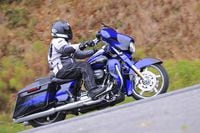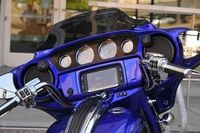[Editor’s note: While we had an opportunity to ride the new Touring models powered by the Milwaukee-Eight engine prior to the general press launch, that experience was limited to a day of track riding at Blackhawk Farms Raceway (click here for video and words on that ride). Wanting more highway experience on the bikes, we sent longtime motojournalist Dain Gingerelli to the official press event in Washington state.]
Harley-Davidson says: "All new four-valve engine and suspension." Motorcyclist says: "Doubling down on valves, staying pat on styling."
Harley-Davidson's top-selling models for the past decade or so have come from its Touring lineup. The blue-chip labels include the Electra-Glide, Road Glide, Road King and above all, the Street Glide. Add to that mix the CVO editions of the Road Glide Ultra and Street Glide, and it's no surprise that these models received the new four-valve Milwaukee Eight update; the rest of the Big Twin bikes report for 2017 deployment powered by the trusty ol' Twin Cam 103.
Given that scenario, what awaited our small army of motojournalists at the 2017 new-model preview on Washington’s scenic (and rainy) Olympic Peninsula was an equally small contingent of 2017 Touring models for us to sample. The bike I focused on was the brilliant black and candy-blue CVO Street Glide sporting new Mirror Chrome Aggressor wheels. Specifically, the CVO’s new paint scheme is labeled Dark Slate Candy/Arctic Black, and I’d really like to know how the guys in marketing come up with these unique names.
Regardless, it’s time to take this $37,799 beauty on the road. Come to papa, Big Blue.
The CVO’s Twin Cooled Milwaukee-Eight 114 engine is the highest upgrade available for Harley’s new single-cam engine, and what you get beneath the blacked-out cases is 114 cubic inches of brute muscle. Air intake begins through the Screamin’ Eagle free-flow air cleaner, and combustion is further regulated by a new SE camshaft. Less restrictive SE mufflers assist in producing claimed maximum torque of 124 pound-feet at 3250 rpm, not to mention a baritone burble at any engine speed.
But forget those numbers—what you’re going to feel pretty much throughout the rev range is the smooth, steady kick of anxious power. Settle into the CVO’s low two-piece seat that places your but 27.2 inches off the deck, thumb the starter button—with plenty of juice in the new charging system the big engine fires up quickly, without the hesitation that’s sometimes associated with the Twin Cams—and snick the six-speed Cruise Drive transmission into first gear. You’ll still hear that familiar “clunk” as the dogs inside bark at your command, that despite Harley performing a few minor tweaks inside to help reduce noise.
You’ll also notice that the CVO’s ergonomics pretty much mirror those of previous Project Rushmore touring models. That holds true for all the 2017 Touring bikes such that hand controls remain in familiar places, while wind management is unchanged with the batwing fairing and lowers. Harley claims that minor improvements to the transmission, primary and clutch assemblies result in less resistance at the clutch lever, too, but it’s so minimal that I can’t discern any difference from the 2016 bikes.
There’s a difference in torque, though, and you feel the single-cam engine’s pull much lower in the rev range than that of a Twin Cam. By 1,500 rpm your CVO ride surges forward at a rapid rate, and a smile plants itself on your face by 2,000 rpm. Before the analog tachometer’s needle sweeps to 3,000 rpm that smile stretches to a full-on ear-to-ear grin; this liquid-cooled (cylinder heads only) engine pulls strongly, allowing you to cruise at a sedate 60 mph in top gear if you wish. Try that with any Twin Cam variation. Not in the cards.
When it’s time to overtake a vehicle on the highway, downshifting is optional. The big Milwaukee-Eight answers the call eagerly, steaming full-speed ahead. However, drop down a gear or two and you’ll like the results even more. Like I stated, though, downshifting is optional with the 114-incher.
The other big news for 2017 is found in the new suspension, front and rear. Up front the fork legs contain Showa Dual Bending Valve technology that boasts improved performance over the range of travel. Travel, by the way, is 98mm, or in Harleyite parlance, 3.92 inches, and the result is a more planted feel up front than before.
Out back, like all the Touring models, the CVO Street Glide rides on new hand-adjustable emulsion shock absorbers. Even though riding on shorter-length shocks (a low silhouette is part of this CVO’s signature, after all), preload range is claimed to be 15mm more than last year’s CVO model. Moreover, the new shock’s left-side-only preload adjustment knob can be turned by hand, no tools required.
Best of all, the new suspension offers an improved ride over last year’s CVO Street Glide. But don’t expect a Cadillac-like ride—the rules of physics prevail. The short shocks’ 2 inches of travel and are prone to bottom over abrupt dips and bumps in the road. No doubt, the ride is improved over last year’s models, but travel reduction by about an inch compared to the rest of the Touring lineup’s shocks means you’ll feel more bumps in the road, plain and simple.
Turn-in for corners remains light for such a big bike, and the Dunlop tires offer good traction at full lean. The stylish footboards will scrape the pavement if you’re not careful, but overall cornering clearance is surprisingly good for such a low-riding bagger.
Harley engineers focused on improving rider comfort this year, and part of the rethink was to the engine itself. For instance, the air cleaner has been tucked in to minimize rubbing your right knee against it, and vibration is reduced considerably. Oh, you’ll still experience the familiar jiggling in the frame of the rubber-mounted engine at idle, but it’s not as apparent as before. As Alex “Boz” Bozmoski, who headed the new engine’s development put it, there’s still a “sweet spot” in the idle vibration to satisfy diehard Harley riders without offending or scaring away potential new customers.
I’ll add this: there’s a sweet spot of torque pretty much throughout the engine’s power delivery to satisfy all riders. The engine’s performance is that much better than the old Twin Cam’s power delivery.



















/cloudfront-us-east-1.images.arcpublishing.com/octane/P27AWSJIQH5CXFTJKXQKNACQHU.jpg)
/cloudfront-us-east-1.images.arcpublishing.com/octane/VZZXJQ6U3FESFPZCBVXKFSUG4A.jpg)
/cloudfront-us-east-1.images.arcpublishing.com/octane/QCZEPHQAMRHZPLHTDJBIJVWL3M.jpg)
/cloudfront-us-east-1.images.arcpublishing.com/octane/HXOUJXQWA5HBHGRO3EMJIGFMVI.jpg)

/cloudfront-us-east-1.images.arcpublishing.com/octane/3TIWWRV4JBBOLDVGRYECVVTA7Y.jpg)
/cloudfront-us-east-1.images.arcpublishing.com/octane/KIX5O23D5NAIBGFXBN3327DKZU.jpg)
/cloudfront-us-east-1.images.arcpublishing.com/octane/7GJYDUIPXRGMTMQKN6ONYOLBOU.jpg)
/cloudfront-us-east-1.images.arcpublishing.com/octane/MUQLOVLL2ZDGFH25ILABNBXKTI.jpg)
/cloudfront-us-east-1.images.arcpublishing.com/octane/TNOU5DNE2BC57MFPMGN2EIDXAM.jpg)
/cloudfront-us-east-1.images.arcpublishing.com/octane/GTCXACQGJ5HAPDTGWUQKDEH44E.jpg)
/cloudfront-us-east-1.images.arcpublishing.com/octane/S35YGSEMEZB4BLTDJTSZPF4GLA.jpg)
/cloudfront-us-east-1.images.arcpublishing.com/octane/5UOT6HPX2JFMRJAX6EH45AR4MQ.jpg)
/cloudfront-us-east-1.images.arcpublishing.com/octane/OKWOJWAKP5EP3OACCRRWPCIX2Q.jpg)
/cloudfront-us-east-1.images.arcpublishing.com/octane/2WF3SCE3NFBQXLDNJM7KMXA45E.jpg)
/cloudfront-us-east-1.images.arcpublishing.com/octane/G4MG6OUCJNBSHIS2MVVOTPX65E.jpg)
/cloudfront-us-east-1.images.arcpublishing.com/octane/IIGGWFOTOJGB7DB6DGBXCCMTDY.jpg)
/cloudfront-us-east-1.images.arcpublishing.com/octane/QSTCM6AVEZA5JJBUXNIQ3DSOF4.jpg)
/cloudfront-us-east-1.images.arcpublishing.com/octane/U4I7G625B5DMLF2DVIJDFZVV6M.jpg)
/cloudfront-us-east-1.images.arcpublishing.com/octane/B6XD6LS6IVCQPIU6HXDJSM3FHY.jpg)
/cloudfront-us-east-1.images.arcpublishing.com/octane/ICL63FEDDRDTTMINYICCEYGMDA.jpg)
/cloudfront-us-east-1.images.arcpublishing.com/octane/FCGZHQXRBZFLBAPC5SDIQLVF4I.jpg)
/cloudfront-us-east-1.images.arcpublishing.com/octane/WNOB6LDOIFFHJKPSVIWDYUGOPM.jpg)

/cloudfront-us-east-1.images.arcpublishing.com/octane/X33NU3E525ECRHXLNUJN2FTRKI.jpg)